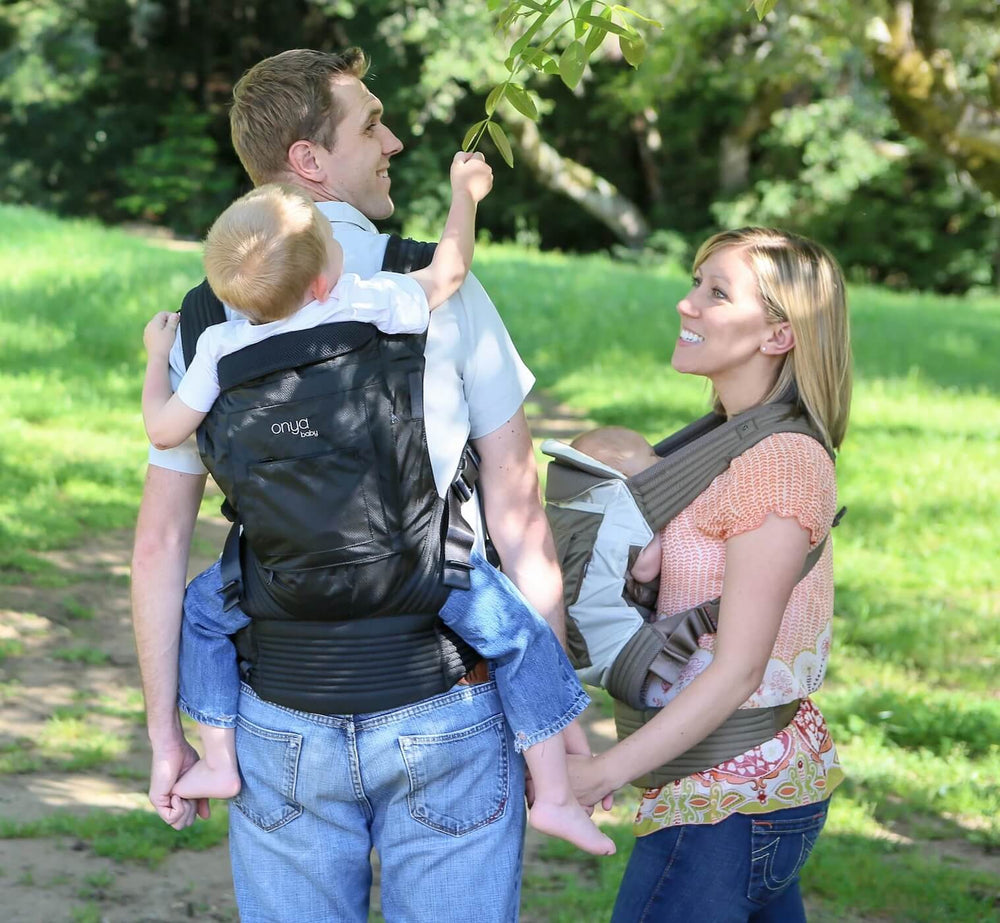Babywearing While Pregnant: Part One

The first in a two-post series about babywearing while pregnant;
by Dr. Daniel Dodge, DC, CACCP
“Can I keep wearing my baby now that I am expecting again?” – This is a common question I am asked in my practice as a family chiropractor. Second-time mothers and mothers of more than two children want to make the best choices they can for their body and their growing baby, while still enjoying the benefits of babywearing their older child. I am happy to share a few guidelines on how to do so safely and comfortably. So, YES! You can wear you baby or toddler while pregnant! It is completely safe for most women to continue to babywear throughout pregnancy. There are many benefits to babywearing, for mother and baby, and these benefits do not have to end when expecting a new brother or sister. To ensure that babywearing continues to be safe and comfortable for both the mother and toddler, there are additional factors to consider during pregnancy. The health of the mother, her level of babywearing experience, the stage of pregnancy, and the weight of the ‘wearee’ should all be taken in to account, as well as any recommendations given by a healthcare provider.

Considerations for Babywearing While Pregnant
There are several things that should be considered while babywearing during pregnancy:
First, how experienced of a babywearer are you? Experienced babywearers who carry their baby or toddler with great frequency and duration typically do not have problems continuing to do so into pregnancy. Those who are less frequent babywearers may not be accustomed to carrying their 20-30 pound child around for long periods of time. Women who are less experienced or wear less frequently may need to either continue with their normal frequency and duration of carrying, or lessen the duration and frequency slightly as they progress further into pregnancy.
As women advance into pregnancy and their new baby begins to grow, their ligaments begin to get a little looser due to presence of the hormone relaxin. Often, this means mothers will need to alter the way they wear their child. Front carries may not be comfortable anymore as pregnancy progresses. Sometimes mothers can get away with carrying their child above the baby bump for a while, but at a certain point front carries will become uncomfortable. The postural misalignment that is common with pregnancy, a hyperlordosis of the lumbar curve (tilting the pelvis forward and sticking the bottom out), is often worsened with front carries as mothers advance in pregnancy.
Back carries or side carries, either in a wrap or soft-structured carrier, are a good substitute in these circumstances and can be a lot more comfortable. They can help counterbalance weight distribution and can even add extra support for the growing belly. When a mother wears her toddler with good posture and strong core muscle activation, back carries during pregnancy are very comfortable and safe.

One of the most important guidelines of babywearing (while pregnant or not) is to pay attention to your body’s cues and to not push through feelings of discomfort, pain, fatigue or any other symptoms including nausea, dizziness, lightheadedness, etc. Sometimes the weight of the baby or toddler being worn can be too much for the mother during the later stages of pregnancy. It is important to lessen the frequency or duration of babywearing when this is the case. The extra pounds gained during pregnancy along with the 20-30 pounds of an older child can become a significant stress on the mother. There is less stability in the pelvis and low back due to relaxin, which causes loosening of the ligaments throughout the body to prepare for birth. The muscles surrounding the spine and hips (the core, back, and buttocks muscles) work harder to stabilize the pelvis and low back, which can lead to pain, muscle soreness, and discomfort. When a mother experiences these symptoms, it is important for her to stop wearing her older child and visit her prenatal certified chiropractor or care provider.
It is important to know that while some women are able to babywear with ease throughout their entire pregnancy, this may not be the case for others. Each trimester brings its own challenges, from fatigue and morning sickness to low back, hip or pelvic pain. Each woman, and each pregnancy, is different. It is important to adapt the wearing frequency, duration, and position based on the situation, using what your body tells you as a guide.
Be sure to read the follow-up post for this two-part series: Safe Carrying Options for Babywearing while Pregnant!
About the Author: Dr. Daniel Dodge, DC CACCP is a board certified prenatal and pediatric chiropractor with a family wellness practice in the Dallas/Fort Worth Area of Texas. He has been wearing his own two children since his son’s birth in 2010. He and his wife offer babywearing support and consultations to patients and local families as part of their mission to provide holistic wellness care to the entire family. You can also find them on Facebook.
Dr. Daniel Dodge, DC CACCP is a board certified prenatal and pediatric chiropractor with a family wellness practice in the Dallas/Fort Worth Area of Texas. He has been wearing his own two children since his son’s birth in 2010. He and his wife offer babywearing support and consultations to patients and local families as part of their mission to provide holistic wellness care to the entire family. You can also find them on Facebook.








